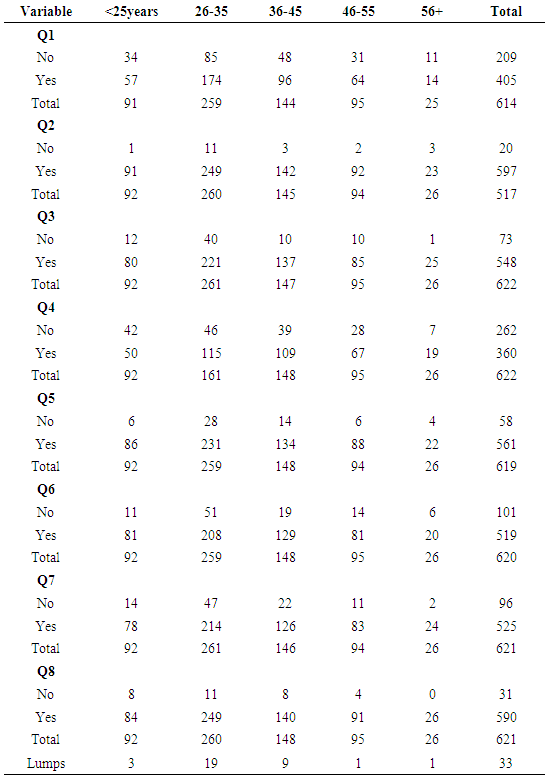-
Paper Information
- Paper Submission
-
Journal Information
- About This Journal
- Editorial Board
- Current Issue
- Archive
- Author Guidelines
- Contact Us
Clinical Medicine and Diagnostics
p-ISSN: 2163-1433 e-ISSN: 2163-1441
2019; 9(1): 14-19
doi:10.5923/j.cmd.20190901.03

Breast Self-examination's Trainees' Levels of Knowledge about Breast Cancer's Features of Early Detection in Qurayyat, Northern Saudi Arabia
Abdelbaset Mohamed Elasbali1, Ziad Alonzi2, Elyasa Mustafa Elfakia Mohammed1, Hisham Mohamed Osman1, Gamal Eldin Mohamed Osman Elhussein3, Ashwag Mardi Al-Ruwaili1, Reham Hazzaa Al-Ruwaili1, Manal Ayed Alazmi1, Hussain Gadelkarim Ahmed3, 4
1Department of Clinical Laboratory Sciences, College of Applied Medical sciences, Jouf University, Qurayyat, KSA
2Department of Clinical Laboratory Sciences College of Applied Medical Science, Jouf University, Sakaka, Jouf, Saudi Arabia
3College of Medicine, University of Hail, Kingdom of Saudi Arabia
4Department of Histopathology and Cytology, FMLS, University of Khartoum, Sudan
Correspondence to: Hussain Gadelkarim Ahmed, College of Medicine, University of Hail, Kingdom of Saudi Arabia.
| Email: |  |
Copyright © 2019 The Author(s). Published by Scientific & Academic Publishing.
This work is licensed under the Creative Commons Attribution International License (CC BY).
http://creativecommons.org/licenses/by/4.0/

Background: Breast self-examination (BSE) is one of the accepted and cost-effective breast cancer screening methods, which can effectively contribute to the prevention and early detection efforts. The present study aimed to assess the level of knowledge of BSE's trainees about features for early detection of the breast lumps in Qurayyat, Northern Saudi Arabia. Methodology: This is a descriptive study that included 626 Saudi women volunteers living in the city of Alquriat, Northern Saudi Arabia. Participants were randomly selected by simple random method regardless of age, gender, education level or occupation. For BSE, only those agreeing to participate in the breast self-examination workshop were included. Results: Inquiries regarding features of breast lesions covered; Do you know the signs that you can consider during doing BSE”, 64.7% stated “Yes” and the remaining 35.3% stated “No”; “Can you identify a present breast lump”, 95.4% stated “Yes” and the remaining 4.6% stated “No”; “Can you distinguish the differences in the appearance of the two breasts” 87.5% stated “Yes” and the remaining 12.5% stated “No”. Conclusion: There is a relatively higher level of knowledge of breast signs that can be measured in the course of BSE. Accidental detection of 5.3% of breast lesions in this randomize sample, necessitate the importance of a primary screening program, as well as, implementation of BSE training programs in Northern Saudi Arabia.
Keywords: Breast cancer, Breast self-examination, Saudi Arabia, Breast lumps
Cite this paper: Abdelbaset Mohamed Elasbali, Ziad Alonzi, Elyasa Mustafa Elfakia Mohammed, Hisham Mohamed Osman, Gamal Eldin Mohamed Osman Elhussein, Ashwag Mardi Al-Ruwaili, Reham Hazzaa Al-Ruwaili, Manal Ayed Alazmi, Hussain Gadelkarim Ahmed, Breast Self-examination's Trainees' Levels of Knowledge about Breast Cancer's Features of Early Detection in Qurayyat, Northern Saudi Arabia, Clinical Medicine and Diagnostics, Vol. 9 No. 1, 2019, pp. 14-19. doi: 10.5923/j.cmd.20190901.03.
1. Introduction
- Breast cancer is a global public health concern, affecting over two million individuals around the world each year [1]. To minimize the burden of the disease, a community-based awareness, as well as, health policy interventions are essential measures in the line of prevention and control. Reducing exposure to breast cancer risk factors, identifying at-risk population and implementing risk-stratified, optimizing screening strategies are the top priority measures [2, 3].Breast self-examination (BSE) is one of the screening measures, which can effectively contribute to the prevention and early detection measures. Regardless of its efficacy in the early detection of breast cancer, it can raise the knowledge and awareness of the population. Implementing breast self-examination education to a risk population can act as secondary prevention, particularly among less educated groups [4].In the lack of planned public education programs on breast cancer, patients usually attend with advanced stages of breast cancer, which is hugely linked to poor prognosis. Consequently, screening through implementing sustainable programs can at least detect and treat the disease at the early stage before its metastasis [5].Breast cancer represents the 9th leading cause of death among Saudi women, and to minimize the burden of the disease and appropriate information regarding breast cancer overall management are highly desired [6]. In Saudi Arabia, there is a considerable rise in the prevalence of breast cancer, particularly amongst younger women [7, 8]. This increase in the incidence of breast cancer among Saudi women may be attributed to several breast cancer modifiable risk factors, such as dietary factors, hormonal factors, early menarche, obesity, lactation status, physical inactivity, etc. [9]. Joint efforts toward breast cancer prevention and control are highly recommended in Saudi Arabia. Breast self-examination represents an easy way to deliver knowledge, cost-effective and easy to share a large section of the at-risk population. Therefore, the present study aimed to assess the level of awareness of BSE's trainees about features for early detection of the breast lump in Qurayyat, Northern Saudi Arabia.
2. Materials and Methods
- This is a descriptive study that included 626 Saudi women volunteers living in the city of Alquriat, Northern Saudi Arabia. Participants were targeted in different public settings in the city. Participants were randomly selected by simple random method regardless of age, gender, education level or occupation. For BSE, only those agreeing to participate in the breast self-examination workshop were included. During the workshop, educational items were delivered (for within and after benefits). A purposeful questionnaire was designed and used for obtaining the necessary data. Beside demographical data of the participants, the poll included inquiries (Qs): “Do you know the signs that you can consider during doing BSE”, ”Can you identify a present breast lump”, “Can you distinguish the differences in the appearance of the two breasts”, “Is a change in the size of the breast a sign to be reported”, “Is a change in the color of the skin with swelling a sign to be reported”, “Is appearance of nodules on the surface of the skin a sign to be reported”, “Is the breast pain a sign to be considered”. Data AnalysisStatistical Package for Social Sciences (version 16) was used for analysis and to perform the Pearson Chi-square test for statistical significance (P-value). The 95% confidence level and confidence intervals were used. A p value less than 0.05 was considered statistically significant.Ethical ConsentEach participant was asked to sign a written ethical consent during the questionnaire’s interview. The informed ethical consent form was designed and approved by the ethical committee of the Applied Medical Science ( Qurayyat. Jouf University, Saudi Arabia) Research Board.
3. Results
- About 626 Saudi women were enrolled, aged 16 to 72 years old and a mean age of 36 years. Inquiries regarding features of breast lesions included; "Do you know the signs that you can consider during doing BSE”, 405/626(64.7%) stated “Yes” and the remaining 221/626(35.3%) stated “No”; “Can you identify a present breast lump”, 597/626(95.4%) stated “Yes” and the remaining 29/626(4.6%) stated “No”; “Can you distinguish the differences in the appearance of the two breasts”, 548/626(87.5%) stated “Yes” and the remaining 78/626(12.5%) stated “No”; “Is a change in the size of the breast a sign to be reported”, 360/626(57.5%) stated “Yes” and the remaining 266/626(42.5%) stated “No”; “Is a change in the color of the skin with swelling a sign to be reported”, 561/626(89.6%) stated “Yes” and the remaining 65/626(10.4%) stated “No”; “Is appearance of nodules on the surface of the skin a sign to be reported”, 519/626(83%) stated “Yes” and the remaining 107/626(17%) stated “No”; “Is the breast pain a sign to be considered”, 525/626(84%) stated “Yes” and the remaining 101/626(16%) stated “No”; “Unusual breast secretions is a sign”, 590/626(94.2%) stated “Yes” and the remaining 36/626(5.8%) stated “No”, as shown in Fig 1.
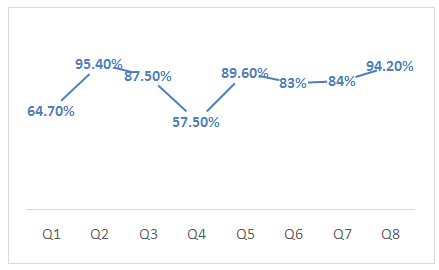 | Figure 1. Proportions of the “Yes” response |
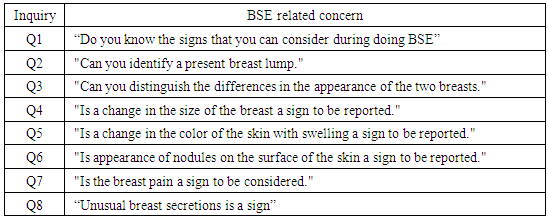 The BSE examination revealed breast lumps in 33(5.3%) of the participants, included 21/33(63.6%) near the axilla, 6/33(18.2%) in the upper part of the breast, 3/33(9.1%) in the lower part of the breast, and 3/33(9.1%) bilateral, as shown in Fig 2.
The BSE examination revealed breast lumps in 33(5.3%) of the participants, included 21/33(63.6%) near the axilla, 6/33(18.2%) in the upper part of the breast, 3/33(9.1%) in the lower part of the breast, and 3/33(9.1%) bilateral, as shown in Fig 2. 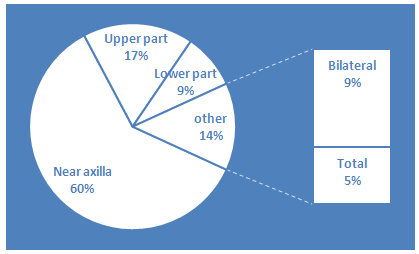 | Figure 2. BSE findings |
|
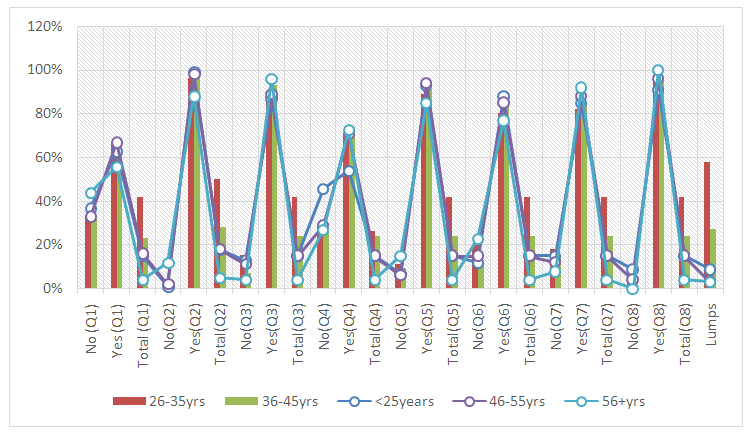 | Figure 3. Inquiries by age proportions |
|
 | Figure 4. Inquiries by educational proportions |
4. Discussion
- Breast cancer continues to frustrate people worldwide. Diverse efforts have been implemented to reduce the burden of the disease. The most successful are those targeting prevention and early detection. Thus the present study was designed to support those efforts in Northern Saudi Arabia, where prevention efforts through raising public awareness are deemed necessary, as well as, early detection through the introduction of an easy and cost-effective method (BSE) may detect many hidden cases.The present incidental examination detected breast lumps in 5.3% of the randomly selected population. Though BSE has lower sensitivity (20% to 30%) particularly among older women when compared with mammography and clinical examination [10], the majority of breast lesions are self-detected. The efficacy of the BSE might be strongly affected by the examiner's competence. Most women performing BSE perform it incompetently [11]. Giving this issue more attention through the strengthening of public training and inspiring competent BSE enactment will permit more chances for earlier detection of many breast tumors.The delivered inquiries were made before the BSE workshop to assess their previous knowledge in this context. Q1. "Do you know the signs that you can consider during doing BSE," 64.7% stated "Yes." This indicates a relatively average knowledge about BSE, concerning the absence of a standard answer. In a cross-sectional study to evaluate the breast cancer knowledge, awareness and issues related to the practice of BSE amongst females in Oman, only 43% did it, and only 21% of them perform it monthly on a fixed basis. The leading excuses for regular practice are fear of breast cancer (9%), doctor's advice (6%) and awareness through media (5%) [12]. The present study didn't consider the sources of knowledge or the previous BSE experiences, which is a limitation portion. Another survey from Jordan found that about 51.8% of the studied group were aware of breast cancer [13]. Another study from Saudi Arabia found that 50.5% were aware of breast lump as a warning sign of breast cancer, 57.5% claimed that family history was a risk factor, 20.5% had undergone breast screening, 79% heard about BSE, and 47.5% knew how to perform BSE [14].The Q2. "Can you identify a present breast lump," 95.4% stated "Yes." The breast lump is one of the most apparent signs in BSE and every woman when hearing about breast cancer will instantaneously contemplate on breast lumps. The Q3. "Can you distinguish the differences in the appearance of the two breasts," 87.5% stated "Yes." Although the percentage is higher here, many women couldn't notice the difference in the absence of visible lesion (can't identify mild diffused lesions). Such an excuse is a case in Q4. "Is a change in the size of the breast a sign to be reported," 57.5% stated "Yes," and in Q5. "Is a change in the color of the skin with swelling a sign to be reported," 89.6% stated "Yes.Q6 "Is appearance of nodules on the surface of the skin a sign to be reported," 83% stated "Yes." Several conditions can be associated with lumps appear on the surface of just beneath the skin shouldn't be reported as breast lesions. Such conditions may be inflammatory or Allergic disorders. Although neoplastic lesions are circumscribed and firm in most instance, any lump should be reported to the health provider.Q7. "Is the breast pain a sign to be considered," 84% stated "Yes. Although this point was stated "Yes" by a high percentage of the participants in this study, early breast cancer is not commonly associated with pain. Pain, tenderness usually associated with inflammatory changes of the breast or it may be associated with inflammatory breast cancer, which is a rare disease [15].Q8. "Unusual breast secretions is a sign," 94.2% stated "Yes. In many occasions, spontaneous nipple secretions may be associated with neoplastic breast lesions, particularly if from one side. Though several benign breast lesions can present with nipple discharge, a rare type of breast carcinoma can also present with characteristics nipple discharge at the early stages of the disease [16]. Nipple secretion been suggested as a source of secreted proteomes that reflect early pathological alterations in the ductal-lobular epithelial microenvironment, and could, therefore, offer breast-specific cancer biomarkers that could be retrieved noninvasively as a novel clinical diagnostic procedure [17]. About the age, individuals with high levels of awareness were those in age groups 36-45 and 26-35 years. On the other hand, people with university-level followed by the secondary level were the most frequently aware of the signs that can be detected during BSE. These subdivisions of the population imitate the more educated and life-experienced people.Although, the current study presented useful information on the current status of BSE, as well as, the status of breast lesions in Northern Saudi Arabia, it has some limitations, including its cross-sectional setting, accumulation in age range 30-40years, and aggregation of participants at the university level of education.In conclusion: There is a relatively higher level of knowledge of breast signs that can be measured in the course of BSE. Accidental detection of 5.3% of breast lesions in this randomize sample, necessitate the importance of an urgent screening program, as well as, implementation of BSE training programs in Northern Saudi Arabia. Further studies with optimized age ranges and education levels may better assess the influence of factors like age and education.
 Abstract
Abstract Reference
Reference Full-Text PDF
Full-Text PDF Full-text HTML
Full-text HTML